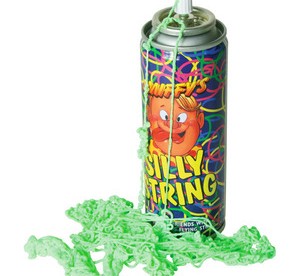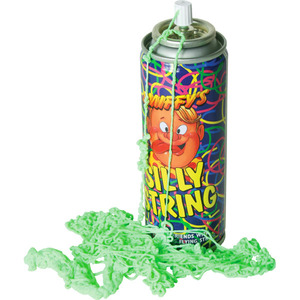A Not-So-Silly Use for Silly String


If you’re unfamiliar with the item pictured above, it’s Silly String — liquefied plastic compressed in an aerosol can. Point it at your friend, hit the button, and the liquid plastic comes shooting out. It dries as it flies through the air, leaving a string (hence the name) of dried plastic in its path. The end result, if you’re spraying the whole canister in one outing (and really, who can resist?), is dozens of ten-foot long strands of Silly String on you, your friends, the floor, the ceiling, and virtually everywhere else. It’s fun, but it’s a big mess. It’s so messy, in fact, that some areas have restricted its use and sale. For example, if you’re armed with Silly String in Los Angeles on Halloween, you’re subject to a $1,000 fine.But that’s not the norm. In most places, Silly String is tolerated; and in some places, its use is encouraged. One of those latter examples? Surprisingly, Iraq. There, it’s quite welcome — especially if you’re wearing a U.S. military uniform.
But getting it there? That’s a bit of a trick.
In 2006, a soldier serving in Iraq named Todd Shriver contacted his parents in New Jersey, asking that mom and dad send him some Silly String. The request wasn’t a sophomoric one, though; Shriver wasn’t going to use the Silly String to play a practical joke on the other members of his detail or for revelry at all. Rather, he planned using it for something which could one day save his life or the lives of others: bomb detection.
It is not uncommon for buildings in Iraqi war zones to be booby trapped, with bombs rigged to explode when someone enters the room. The bombs are triggered when an entrant stumbles into a thin, nearly invisible tripwire, leaving almost no time for escape. For soldiers, entering an unoccupied room is therefore a gamble — unless you can somehow detect the tripwire before crossing it. Enter Silly String. It travels far enough where a soldier can shoot it across most rooms, and it’s light enough such that if some Silly String lands on the tripwire, it won’t cause bomb to explode. Fire the Silly String and if it hangs in the air, it’s snagged on something — and therefore, the room is best avoided. Pretty clever, right?
When Todd Shriver’s mother, Marcelle, heard the reasoning for Todd’s request, she decided that sending her son a can or two of Silly String wasn’t enough. She wanted to get as many cans of the stuff to as many soldiers as possible, and over the course of the next few months, amassed 80,000 of them. She and others packed and addressed the cans to individual servicemen and women in Iraq and was able to ship a few off. Bomb detection was about to become easier.
But she shortly ran into a problem. It turns out that private parcel carriers — companies like FedEx, UPS, and DHL — are prohibited from shipping aerosol cans. The lion’s share of the 80,000 cans were stuck under a blue tarp at a local shipping company in Deptford Township, New Jersey — one that wasn’t authorized to transport hazardous items. And finding one that was — and could make shipments to Iraq — proved expensive and bureaucratically difficult. As the New York Times reported, as of June 2007, the Shrivers’ cache of Silly String was stuck.
It took roughly a year, but finally, a qualified shipper stepped in. As CBS reported in October of 2007, a New Jersey-based company authorized to ship aerosol cans to Iraq learned about the Shrivers’ efforts and delivered the entire payload of Silly String to Iraq.
 Bonus Fact: Silly String was originally designed, in the words of Wikipedia, “to create a can of aerosol that one would be able to spray on a broken/sprained leg or arm and use as an instant cast.” It’s rise to iconic toy status was accidental — the inventors noticed that, given an appropriately-sized nozzle, the spray cast prototype was a lot of fun to shoot at one another. But the inventors’ marketing plan needed even more luck. They took their product to an executive at toy company Wham-O and, in the meeting, sprayed the exec’s office with plastic strings. The now-angered executive passed on the product, but couldn’t clean his office thoroughly; a piece of Silly String stuck to a lamp shade. Wham-O’s owners noticed the remnant string, asked what it was, and the company decided to do a market test as a result.
Bonus Fact: Silly String was originally designed, in the words of Wikipedia, “to create a can of aerosol that one would be able to spray on a broken/sprained leg or arm and use as an instant cast.” It’s rise to iconic toy status was accidental — the inventors noticed that, given an appropriately-sized nozzle, the spray cast prototype was a lot of fun to shoot at one another. But the inventors’ marketing plan needed even more luck. They took their product to an executive at toy company Wham-O and, in the meeting, sprayed the exec’s office with plastic strings. The now-angered executive passed on the product, but couldn’t clean his office thoroughly; a piece of Silly String stuck to a lamp shade. Wham-O’s owners noticed the remnant string, asked what it was, and the company decided to do a market test as a result.
From the Archives: Headless Potato: The history of Mr. Potato Head, his bucket of parts, and the part he didn’t always come with.
Take the Quiz: Name the honorees in the Toy Hall of Fame.
Related: Silly String, of course.
